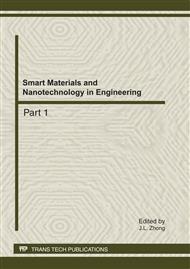p.217
p.223
p.228
p.233
p.239
p.245
p.250
p.257
p.263
A Scale up Submerging Fermentation to Produce Fibrinolytic Enzyme and Mycelia by Cordyceps militaris
Abstract:
A 10 and 100 L fermentor was used to produce Fibrinolytic enzyme and mycelia by Cordyceps militaris, which was based on the optimized results of the flasks ferment of submerging fermentation and with the principle of equivalent KLa. Two operating parameters of the ferment, stirring speed and ventilation were determined. The results showed that, under the identical KLa with flasks, the stirring speed and ventilation were 50 r/min and 700 L/h, 100 r/min and 600 L/h, or 150 r/min and 500 L/h in 10 L fermentor; And the stirring speed and ventilation were 100r/min and 3 m3/h or 150 r/min and 2 m3/h in 100 L fermentor. In the experiments, the stirring speed and ventilation were 100 r/min and 600 L/h in 10 L fermentor; the stirring speed was 250 r/min and ventilation was 2 m3/h in 100 L fermentor, the results were consistent with the optimized conditions in flasks, and the production of both fibrinolytic enzyme and mycelia reached the optimized results in flasks. Therefore, these results are important for producing fibrinolytic enzyme and mycelia by a scale-up of Cordyceps militaris fermentation.
Info:
Periodical:
Pages:
239-244
Citation:
Online since:
September 2011
Authors:
Keywords:
Price:
Сopyright:
© 2012 Trans Tech Publications Ltd. All Rights Reserved
Share:
Citation:


